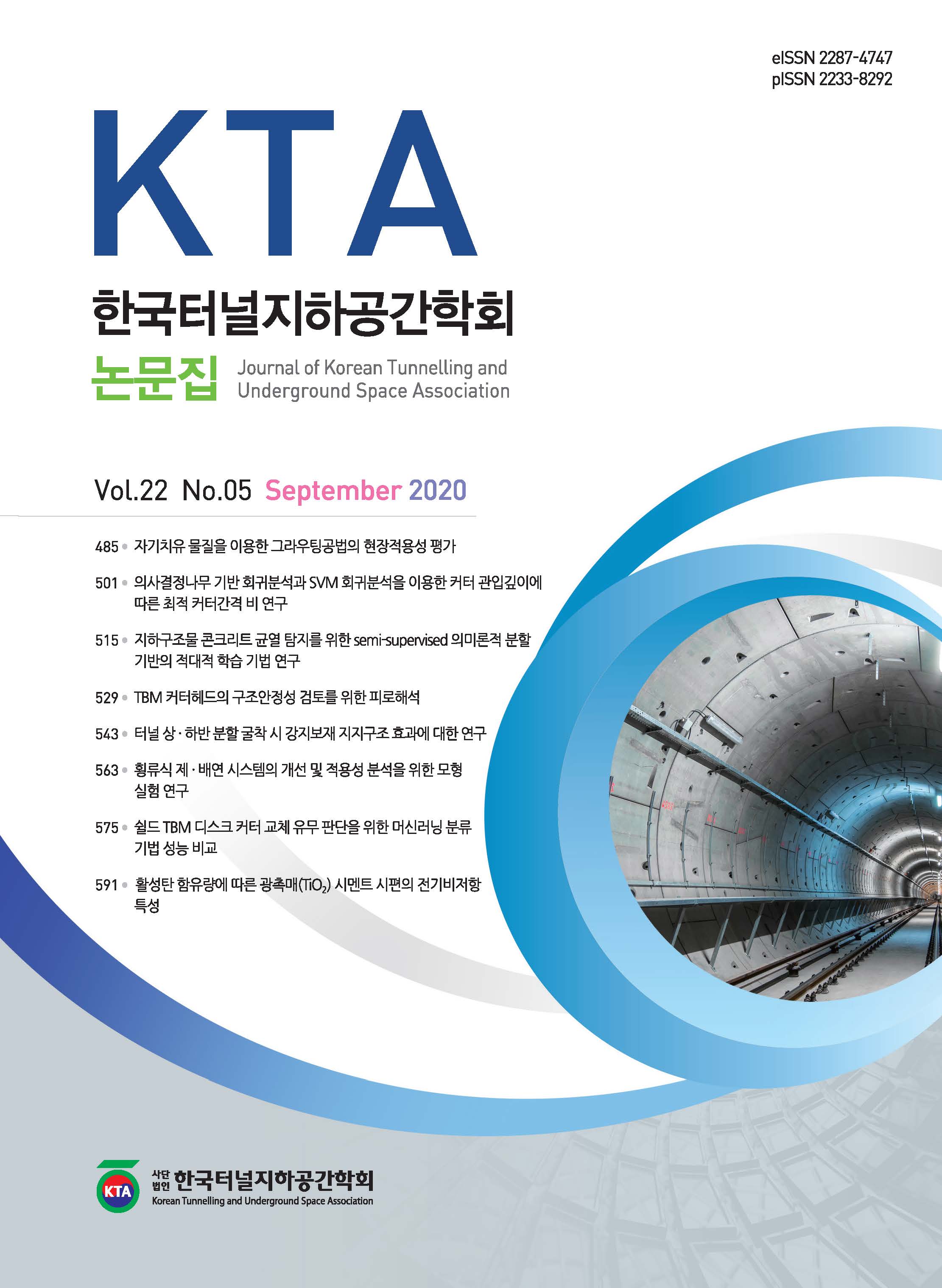- 권한신청
- P-ISSN2233-8292
- E-ISSN2287-4747
- KCI
 ISSN : 2233-8292
ISSN : 2233-8292
공사 중 환기덕트 누풍 최소화를 위한 접속부개발 및 성능평가 연구
A study on the development and performance evaluation of duct coupling for the minimized leakage of temporary ventilation duct
전규명 ((주)범창종합기술)
민대기 ((주)범창종합기술)
김종원 ((주)범창종합기술)
백종훈 ((주)범창종합기술)
- 다운로드 수
- 조회수
초록
초장대 해저터널은 환기를 위한 연직갱 또는 경사갱 설치에 공간적으로 많은 제한을 받게 되므로 일부 인공섬을 건설하여 환기를 수행할 필요가 있다. 그러나 인공섬 설치는 건설의 어려움뿐만 아니라 건설비용이 증가하게 되므로 인공섬 설치를 최소화할 필요가 있다. 이에 따라 환기거리가 증가하여 누풍에 의한 공급 풍량이 커지게 되면, 공사 중 환기를 위한덕트 설치가 불가능해지거나 팬 정압 및 동력이 상당히 증가하게 된다. 따라서 초장대 해저터널을 건설하기 위해서는 이러한 현실적인 문제를 극복하고 시공 중 터널 내 환경을 쾌적한 상태로 유지할 수 있는 기술력이 필요하다. 선행 연구에서 우리는 누풍이 이 문제들을 해결하는 핵심 인자이며 실험 결과 새로운 접속방식의 누풍율은 대략 1.46 mm2/m2임을밝혔다(Jo et al., 2017). 본 연구에서는 새로운 접속방식이 적용된 시제품의 누풍율 측정 결과를 제시하고 기존 접속방식의 누풍 성능 개선을 위해 덕트 내부에 연질막 적용시의 누풍 성능 개선을 실험적으로 분석하였다.
- keywords
- Subsea tunnel, Temporary ventilation, Air leakage ratio, Prototype, Leakage performance, 해저터널, 공사 중 환기, 누풍율, 시제품, 누풍 성능
Abstract
Long subsea tunnel is subject to many restrictions in terms of spatial limitation when vertical or inclined shafts are built for tunnel ventilation. So, the construction of some artificial island is required to provide ventilation. But, because of construction difficulty and cost increase, it is necessary to minimize the artificial island construction. As a result, ventilation distance become longer and supply airflow becomes excessive due to air leakage, So, duct mounting for temporary ventilation is impossible or fan pressure and power increase exponentially. Therefore, in order to build a long subsea tunnel, it is necessary to overcome these practical problems and to develop technical solution that can keep the comfortable condition of tunnel environment during construction. In previous study, we have found that air leakage is the key factor in solving these problems and experimental results show that the new connection method has a leakage rate of about 1.46 mm2/m2 (Jo et al., 2017). In this study, we present the experimental results of the measurement of the leakage rate of the prototype with the new connection method, and analyze experimentally the improvement of the leakage rate when applying the flexible cover inside the duct to improve the leakage performance of the existing connection method.
- keywords
- Subsea tunnel, Temporary ventilation, Air leakage ratio, Prototype, Leakage performance, 해저터널, 공사 중 환기, 누풍율, 시제품, 누풍 성능
참고문헌
Anisdahl, L.M., Johansson, B., Thoen, K. (2008), "Study on the performance of ventiflex ducting and couplings", 12th U.S/North American Mine Ventilation Symposium, pp. 609-613.
ISETH (1978), "Ventilation in underground construction", Institute for Road, Railroad and Rock Construction at the Swiss Federal Institute of Technology Zurich, No. 39, pp. 1-74.
ITA Working Group No. 5 (2011), "Guidance on the safe use of temporary ventilation ducting in tunnels ITA WG5 - Health & Safety in Works", ITA Report No. 008, International Tunnelling and Underground Space Association, pp. 1-9.
JCOSHA (2012), "Ventilation technical guideline of tunnel construction", Japan Construction Occupational Safety and Health Association, pp.156-168.
Jo, H.J., Chun, K.M., Kim, J.W., Lee, J.K. (2015), "A study on the characteristics for temporary ventilation of long subsea tunnels - focused on the current situation and improvement requirements", Journal of Korean Tunnelling and Underground Space Association, Vol. 17, No. 2, pp. 153-166.
Jo, H.J., Min, D.K., Kim, J.W., Lee, J.K., Beak, J.H. (2017), "A study on the air leakage performance improvement of duct coupling for temporary ventilation of long subsea tunnels", Journal of Korean Tunnelling and Underground Space Association, Vol. 19, No. 2, pp. 319-333.
Khanna, R. K. (2008), "Ventilation of long tunnels", World Tunnel Congress, pp. 1898-1910.
KRNA (2012), "KR C-12130", Korea Rail Network Authority, pp.19-32.
MLTM (2011), "Road design manual part6 tunnel, 621 construction phase equipments", Ministry of Land, Transport and Maritime Affairs, Gwacheon, pp. 621.1-8.
Ruben, D., Thorsten, T. (2015), "Designing TBMs for subsea tunnels", Journal of Korean Tunnelling and Underground Space Association, Vol. 17, No. 6, pp. 587-596.
SAREK (2011), "Air-conditioning and refrigerating engineering manual, 3rd edition, part2", The Society of Air-conditioning and Refrigerating Engineers of Korea, pp. 5.2-16.
Shin, Y.K. (1980), "A study on the friction coefficient for domestic vinyl air duct and leakage ratio of duct connectors", Master Thesis, Graduate School of Inha University, Incheon, pp. 1-18.
Shortridge Instruments, Inc. (2009), "Airdata multimeter ADM-880C electronic micromanometer operating instructions", pp. 1-68.
SIA (1998), "SIA 196 - Ventilation in underground", Swiss Society of Engineers and Architects.
Tanizawa. Co., Ltd. (2007), "Duct for long distance tunnels - Guidance of NLF duct", pp. 1-2.
- 다운로드 수
- 조회수
- 0KCI 피인용수
- 0WOS 피인용수

